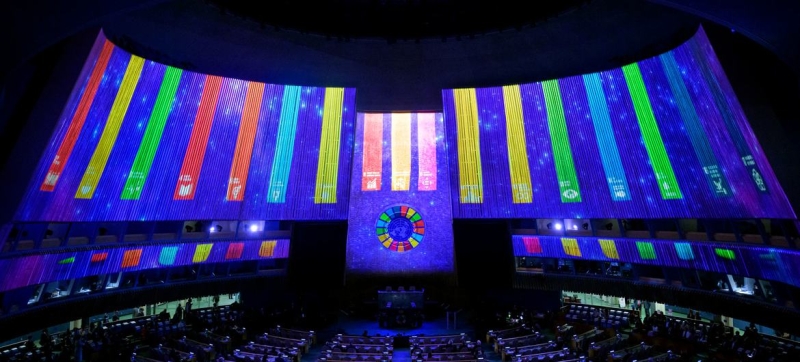
Projection of SDG logos in the UN General Assembly Hall in 2022. UN chief: developing countries pay more on loans than they invest in education and healthcare systems Sustainable Development Goals
Reform of the international financial system and investment in development are needed to help countries cope with widening debt crises. This was stated by UN Secretary-General Antonio Guterres, speaking during a high-level thematic discussion on external debt sustainability and socio-economic equality, which took place on Monday in New York as part of Sustainable Development Week.
The first ever Sustainable Development Week takes place at the UN headquarters in New York under the auspices of the General Assembly from April 15 to 19. A discussion on debt and equality was the first event of the Week.
Time to Invest
According to the UN chief, now is the time for accelerated investment in health, education, clean energy, food and social protection systems, but instead many countries, especially developing ones, are facing financial problems.
“The COVID-19 pandemic and the global consequences of the war in Ukraine have slowed down economic growth and exhausted budgetary resources. Before developing countries could catch their breath, a global cost of living crisis and a post-pandemic inflation shock arrived,” Guterres said.
Financial Architecture
In his opinion, no example of the failure of the international financial architecture is more glaring than its attitude towards debt.
In 25 developing countries, more than a fifth of tax revenue goes to servicing external debt, and global borrowing costs are so high that 3.3 billion people – about 40 percent of the world’s population – live in countries that spend more on interest payments than on health care or education. In 2022, 52 developing countries paid a total of $49 billion more to external creditors than they received in new payments. The Secretary General provided such data in his speech.
Read also:
INTERVIEW | Chairman of the General Assembly – about sustainable development and his vision of the future
He also said that over the past three years, the world has seen 18 sovereign defaults in 10 developing countries, which is the highest number in the last two decades. In addition, 34 of the poorest countries are either in debt crisis or at high risk of debt distress.
A total of 17 countries pay the International Monetary Fund (IMF) more than $2 billion in surcharges a year, the Secretary-General said, and those seeking to restructure their debt are bogged down in protracted negotiations with creditors.
Lifebuoy
“Developing countries need a lifeline to get out of the quicksand of debt,” said Guterres.
Thus, he called for action to achieve the Sustainable Development Goals (SDGs), in particular to expand the availability of long-term financing, primarily through multilateral development banks. The UN chief also reiterated the need to reform the global financial architecture.
“From increasing debt transparency to expanding local currency lending, developing new debt instruments and faster and fairer restructuring processes “We need to find new ways for countries to borrow,” he stressed.
“The Future Summit in September and the Financing for Development Conference next year will be two critical events for making progress in implementing these ideas, addressing long-standing gaps in the global debt architecture and ensuring fairness for developing countries,” the UN chief added.
